Living with Red Foxes
- Meet the Red Fox
- Fox Family Dynamics
- Where do Red Foxes live?
- What do foxes eat?
- The role of the red fox in the ecosystem
- Foxes in Residential Neighbourhoods
- Intentional and unintentional feeding of foxes
- I’ve seen a fox in my backyard, should I be concerned about my children or pets safety?
- Foxes and Cats
- Foxes and Dogs
- Making your backyard less attractive to foxes
- Aversive Conditioning
- When you should implement Aversive Conditioning
- Fox in a schoolyard or playground
- A fox is stalking me!
- A fox has denned on my property
- Can I trap, relocate, or kill nuisance foxes?
- What to do if you see a sick or injured fox
The Red Fox, scientifically known as Vulpes vulpes, stands out as a remarkably versatile and adaptable member of the Canidae family, thriving in a range of habitats, including urban and suburban areas throughout North America. Typically weighing between 7 to 15 pounds, red foxes display a range of coat colors, spanning from bright red to orange. They are further distinguished by their black legs, black-tipped ears, and a tail tipped in white. In winter, their dense, fluffy fur can give them the appearance of being larger than their actual size.

Photo by Vanessa Van Rhijn
Fun Fact!
Despite “red fox” being the commonly accepted name for the species, not all red foxes are actually red! Very occasionally, genetic outliers emerge, leading to reports of melanistic (black or silver-coated) red foxes across the Greater Toronto Area (GTA).
Fox Family Dynamics
Red foxes exhibit intricate family dynamics that play a crucial role in their thriving across diverse environments. Renowned for their monogamous mating pairs, these foxes forge strong bonds that endure well beyond the breeding season. Typically, red foxes breed once a year, with pups (also known as “kits”), being born from March through May. It’s widely believed that litter size directly correlates with food availability, with most litters averaging around 4-5 kits. The family structure centers on the devoted care of both parents toward their offspring. In some instances, non-breeding yearling daughters may serve as “helpers,” aiding their parents by guarding and hunting prey for the younger members of the family. Fox kits, born blind and vulnerable, depend on the nurturing and protective instincts of their family within the safety of a den.
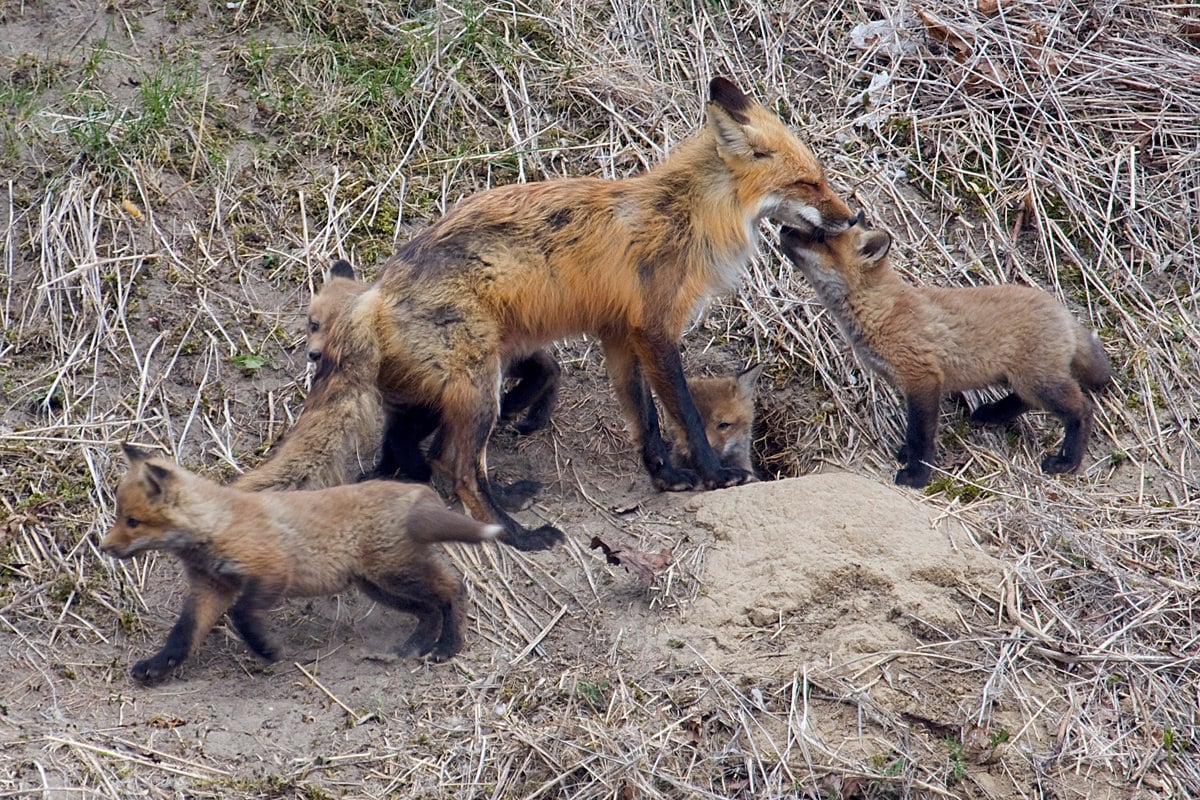
Photo by Ann Brokelman
Foxes excavate dens in loose soil, often co-opting and enlarging burrows previously inhabited by smaller mammals such as groundhogs. They might also dig beneath fallen trees or into a grassy knoll, or inhabit a hollow log or dense brush. In urban environments, it’s typical for foxes to choose den locations such as underneath quiet backyard porches and decks, or burrowing under a shed or other structures. Dens often have more than one entrance to allow a swift escape from danger, and may also have backup dens close by to move their kits when feeling threatened, or occasionally for no apparent reason at all.
While they typically hunt solo, Red fox families engage in the cooperative behaviour of sharing food to ensure the well-being of their young and each other. As the kits grow, they learn essential skills from their parents, gradually gaining independence until they are ready to venture out on their own. This family-oriented structure contributes to the resilience and adaptability of the red fox species across a range of habitats.
Where do Red Foxes live?
The resilient red fox thrives in a wide array of environments, including human-modified landscapes such as cities and residential areas. Remarkably versatile, red foxes can inhabit nearly any environment that provides sufficient food resources and shelter. They are one of Canada’s most widespread mammals as they are found in every province and territory. Their extraordinary adaptability has facilitated extensive range expansions across North America over hundreds of years.
What do foxes eat?
Red foxes have an omnivorous diet, consuming a wide array of animals and plants. Their eating habits vary considerably depending on the season and availability of food. They are adept hunters, and the bulk of their diet consists of a variety of small mammals such as voles, mice, rats, squirrels, and rabbits, as well as birds. Equipped with their notably large ears, red foxes excel at detecting and capturing small prey concealed within dense foliage, leaf litter, or snow. In the spring and summer, foxes supplement their diet with eggs, amphibians, vegetation, fruits, nuts, insects, and carrion. They will frequently bury or stash away surplus food for later – this is called “caching”.

Photo by Ann Brokelman
The role of the red fox in the ecosystem
Foxes serve a multifaceted and valuable ecological role within urban environments. One significant aspect of their contribution is their role as regulators of local wildlife populations. As opportunistic predators, foxes help maintain balance by controlling populations of smaller mammals like rodents and rabbits. This management indirectly supports plant diversity, as excessive herbivore populations can cause damage to vegetation and disrupt local ecosystems. Furthermore, foxes effectively hunt small mammals often considered pests, mitigating their impact on residential and agricultural areas.
Did you know?
Foxes play a crucial role in maintaining equilibrium within landscapes. In fact, foxes can be considered as a sustainable and environmentally friendly approach to managing urban ecosystems!
Foxes excel as scavengers, fulfilling a crucial role in urban environments by aiding in the decomposition of organic matter. By consuming carrion and other organic waste, they actively contribute to cleaning up urban spaces, thereby lowering the risk of disease transmission and enhancing overall cleanliness.
As urban areas expand and intersect with natural habitats, it becomes increasingly important to recognize and value the ecological significance of wild canids. The presence of an apex predator is an indicator of a healthy and balanced ecosystem. This understanding is vital for fostering harmonious coexistence between wildlife and human communities.
Foxes in Residential Neighbourhoods
While it’s recognized that human expansion can be detrimental to wildlife, certain species can benefit from the development of human-inhabited areas, and red foxes are a notable example of this! Red foxes belong to a category known as “synanthropic species,” which thrive in close proximity to humans and directly benefit from human-modified environments such as our gardens, yards, cemeteries and parks, as well as the surplus of food sources they offer. In their natural habitat, foxes occupy the transitional area between ecosystems known as an “ecotone.” These ecotones, such as the transition from woodlands to grasslands, offer foxes a wide array of resources crucial for their survival.
Urban environments, such as residential neighbourhoods, offer a variety of resources akin to those found in natural habitats. These include human-made shelters, ravines, ponds, and travel corridors like roads, railroads, or hydro fields. Additionally, lawns and fields of grass meeting forested areas or green spaces provide similar resources as natural ecotones between forests and meadows. Most prominently, staying close to humans offers an additional advantage for foxes: access to abundant food resources in the form of our food waste and the rodents it attracts, and our intentional feeding of wildlife. Unintentionally, we’ve created ideal environments for these synanthropic species to flourish!
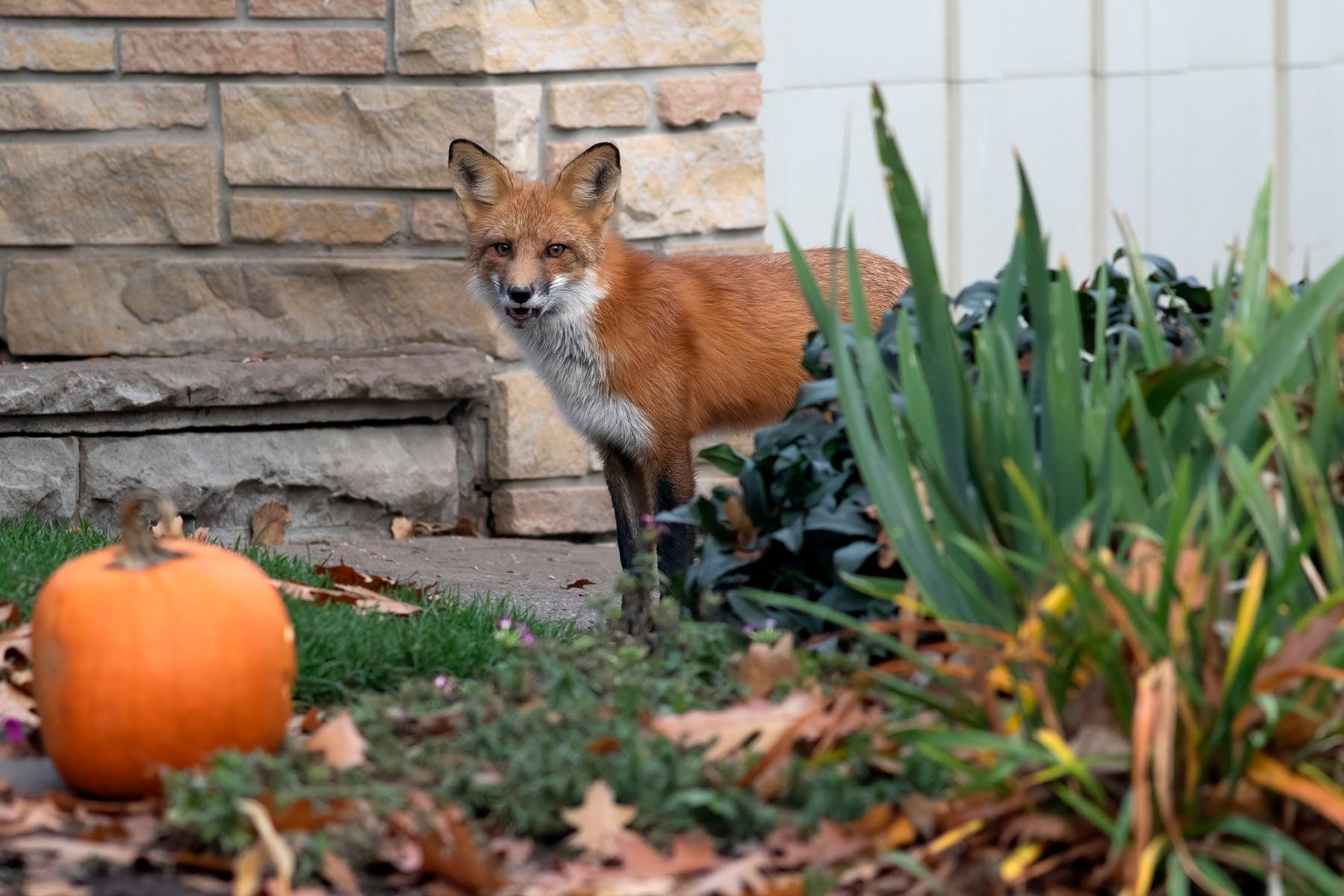
Photo by Ann Brokelman
Although drawn to human-altered environments, foxes instinctively regard humans with fear, perceiving us as potential predators. Most active during dawn and dusk, urban foxes often adapt their behaviour to minimize encounters with humans by becoming more nocturnal. However, seeing a fox during daylight hours is neither uncommon nor necessarily alarming. Various factors may prompt their daytime presence, including increased demands for food during the kit-rearing season or human-sourced food attractants. While foxes typically maintain a baseline fear of humans, events in their lives can erode this fear (such as people feeding them), making them less cautious around people and their homes.
Similar to their domestic dog cousins, foxes are highly intelligent and learn behaviour through accumulated experiences. What may seem like a “neutral” encounter for us, such as quietly observing a fox crossing our path, can be interpreted as a “positive” one from the fox’s perspective. Although the fox may appear uninterested and passive, they learn that being in the presence of a human has no negative consequences. Over time, with repeated similar interactions, the fox may become more comfortable allowing themself to be seen by people, potentially leading to conflicts down the road. It’s crucial to foster a mutual understanding of boundaries to ensure wildlife stays wild.
Intentional and unintentional feeding of foxes
Feeding foxes, whether directly or indirectly, can have significant adverse effects on their behaviour. When given handouts, foxes may find it easier than hunting for natural prey, leading them to approach humans for food. This learned behaviour reduces the natural wariness foxes should have toward humans, which can pose a risk to the animal’s safety. Some individuals may find this behaviour annoying or frightening and may respond in ways that harm the animal. This could range from trapping and relocating a parent fox to setting hazardous traps or baits in their yard, or even physically harming or killing the animal. Toronto Wildlife Centre frequently receives calls about conflicts, many of which involve animals that have clearly been fed by well-meaning individuals but with unintended negative outcomes.
Feeding foxes can also discourage foxes from foraging for their natural food sources. This can lead to health problems, since the foods we choose to feed them are usually not as diverse or nutritionally complete as what they’d find through their natural hunting and foraging. Feeding baby foxes is especially detrimental as it disrupts their natural development and learning process. Young foxes rely on their parents to teach them essential hunting and foraging skills. If they become accustomed to receiving handouts from humans, they may never fully develop these crucial survival abilities. While it may seem compassionate or cute to feed foxes, it is best to let them rely on their natural instincts and maintain the skills they need to thrive in the wild.
Don’t feed wildlife!
Although foxes have a strong fear of humans and don’t view us or our children as potential prey, providing them with direct food can change their perception of humans.
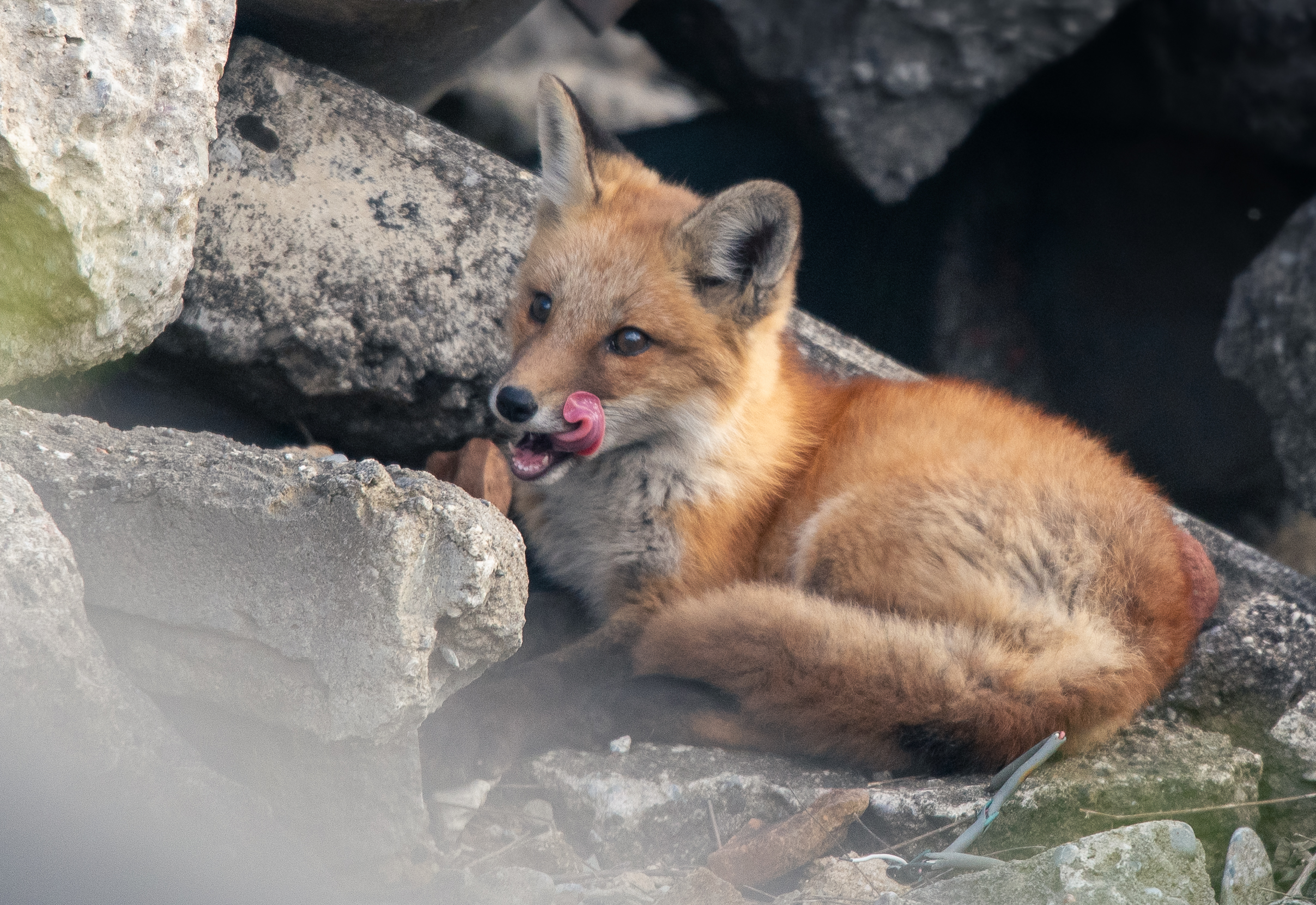
Photo by Clemence Wong
Additionally, indirect or accidental feeding can attract foxes to a neighbourhood. Factors such as improperly contained garbage, litter in public areas like parks or schoolyards, leaving pet food outside, fruit trees, or providing bird seed can be an attracting food source itself, or it attracts the fox’s preferred food sources (such as squirrels, chipmunks, voles, mice, and rats). To ensure the safety of foxes, it’s essential to avoid directly or indirectly feeding wildlife and to promote coexistence through responsible practices.
I’ve seen a fox in my backyard, should I be concerned about my children or pets safety?
Seeing a fox in your yard or around your neighbourhood is a common occurrence and isn’t a cause for concern; it could simply be part of the fox’s routine within their territory. Red foxes are naturally small (~7-11 lbs), elusive, and shy creatures. Red foxes do not perceive humans or their children as either prey or as something they can take on, thus they do not pose a threat to humans. A healthy fox that hasn’t become accustomed to humans will typically steer clear of approaching people or the pets with them, as they prefer to avoid confrontation altogether.
Foxes and Cats
Red foxes primarily prey on smaller animals like mice, rats and birds. The largest animals they typically hunt are rabbits. Adult cats, being similar in size to foxes and known for their self-defense skills, are generally not targeted by foxes due to the foxes’ self-preservation instincts. However, kittens and small adult cats weighing less than 5 pounds could be perceived as prey by a fox.
Outdoor cats face various risks beyond fox predation, including car accidents, attacks by dogs, diseases, parasites, poisoning, getting lost, cruelty from humans, and predation by other wildlife such as hawks. Therefore, if a cat goes missing, it should not automatically be assumed that a fox, or other wild animal, preyed upon them. Taking proactive measures can benefit both foxes and domestic cats.
For more information on keeping cats safe, please refer to our Cats and Wildlife Page at https://www.torontowildlifecentre.com/catsandwildlife/.
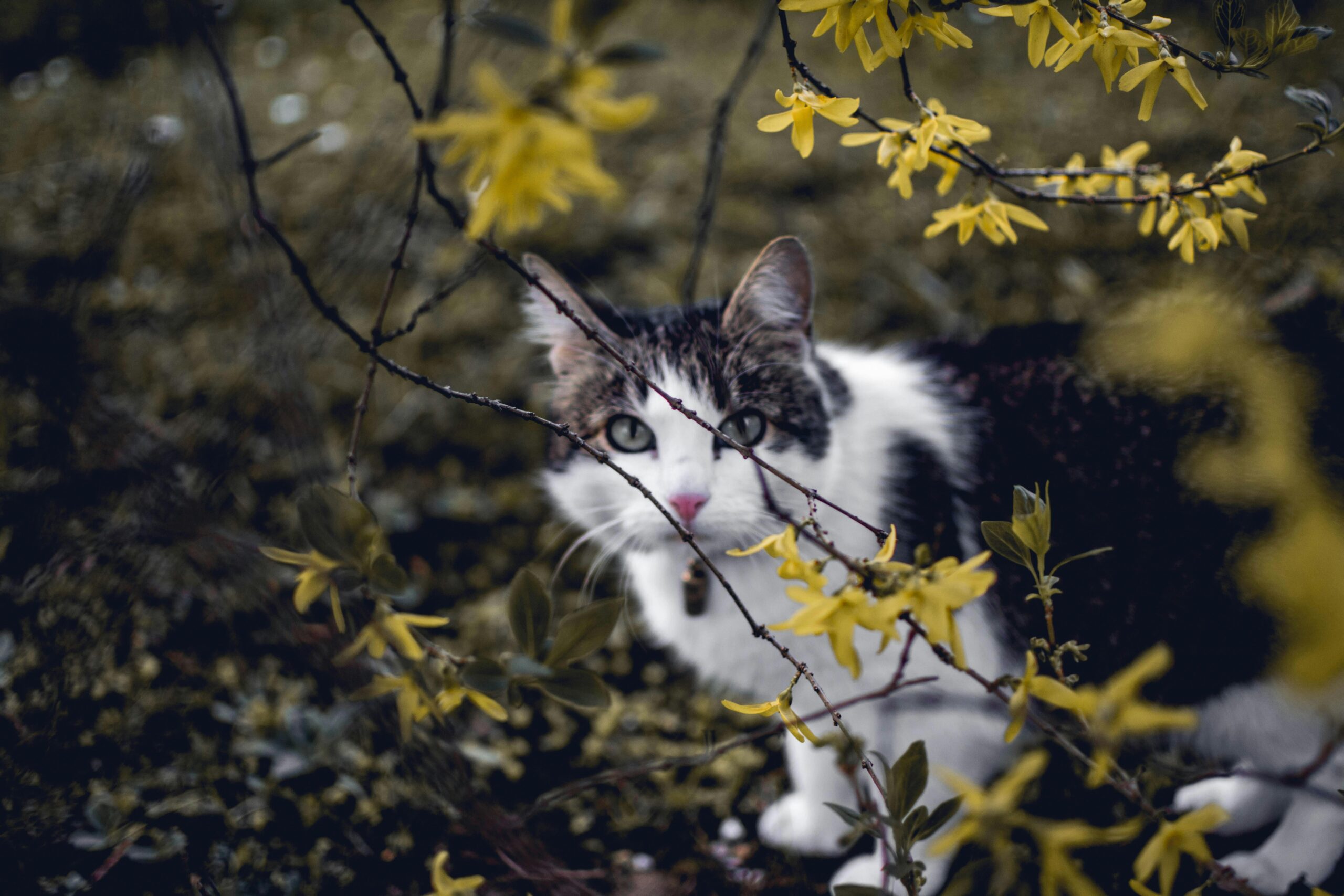
Foxes and Dogs
While most dogs are not at risk of being attacked by a fox unless the dog poses a threat to a den or babies, they should still not be left unattended outdoors as they may encounter various dangers. Interacting with wildlife presents one of these risks. Small dogs, especially toy breeds and puppies, can become targets for a variety of predators, including foxes, if left unattended in open areas.
To avoid potential conflicts, it’s advisable to keep your dog on a non-retractable leash no longer than 3 feet or 1 meter when walking. If you witness a fox during your walk, promptly move on without allowing your dog to bark at or chase them. While foxes prefer to flee rather than engage in confrontation, they may defend themselves if pursued, cornered, or if they perceive their babies to be at risk. Taking proactive measures contributes to maintaining a peaceful relationship between domestic dogs and foxes in shared environments.
Making your backyard less attractive to foxes:

For many people, observing foxes is a wonderful opportunity. If foxes are living in a space where they can be tolerated and left alone, it’s best to leave them be. In cases where they need to be encouraged to move along, you can take the following preventive measures:
Remove all food attractants:
- Secure garbage/compost bins.
- Clear up fallen tree fruits/berries/nuts.
- Keep pet food and water bowls inside.
- Remove food left out for wildlife, including birdfeeders.
MYTH!
MYTH! Placing food out for foxes away from your house will ensure they stay elsewhere.
FACT!
You are only creating a problem in another neighbourhood and there’s no proof that this keeps them out of your yard which they may pass through for a variety of reasons.
Increasing your presence in your yard:
- Foxes typically prefer areas with minimal human activity. By increasing your use and enjoyment of your backyard—whether it’s gardening, doing lawn work, exercising, playing music, or hosting gatherings—you’ll convey the message that the yard is occupied and not an ideal spot for foxes to visit.
Alter the environment to deter foxes:
- If you observe a fox frequently passing through your yard, introduce novel items like a lawn chair or table along their path. Foxes are cautious about changes in their environment, and this can prompt them to avoid your yard.
- Consider installing motion-sensor lights and sprinklers in your yard. The sudden activation of these devices can startle foxes, discouraging them from lingering in your space.
- Repair broken floorboards on porches and close up openings that lead under the house, sheds, porches, or decks.
Implement a tactic called Aversive Conditioning. This involves specific actions to make the foxes uncomfortable, discouraging their presence. (Read on for more details.)
Aversive Conditioning
Aversive Conditioning is the most effective way to communicate to a fox that their presence in a particular area is unwelcome – essentially, it is a method of scaring them away. In most cases, shooing away a fox does not require excessive effort or fierceness.
Here’s a simple guide:
Step 1: Slowly but confidently walk towards the fox and make direct eye contact.
Step 2: Add ACTION: Wave your arms in the air, make yourself appear large and threatening, either by repeatedly popping open an umbrella, or waving around and snapping a large garbage bag. If it’s dark, use a flashlight to shine it at the fox.
Step 3: Add NOISE: Clap your hands, yell (don’t scream), slap a newspaper on your thigh, stomp your feet loudly, shake your car keys, bang pots together, or use a noisemaker like nuts and bolts in a pop can.
Step 4: Slowly make steps toward the fox until they are completely off your property or out of sight. The message needs to be clear and memorable: You are not welcome here.
While it may take a few attempts, as foxes might return hoping it was a one-off, consistent application of aversive conditioning will make them more likely to avoid that location in the future.
Important Note: NEVER run away from a fox, as it may trigger a chase response – a trait also found in domestic dogs.
When you should implement Aversive Conditioning
Foxes that display a proximity tolerance to humans should be reminded to keep their distance through aversive conditioning. This is particularly relevant in scenarios where foxes are trotting down sidewalks or hanging out in parks when people are present. It’s important to note that not every situation calls for aversive conditioning. Foxes should generally be left undisturbed if they are keeping to natural spaces and avoiding people.
NOTE!
Aversive conditioning should NEVER be employed if foxes are cornered, appear sick or injured, or if they are in close proximity to a known den with offspring present. The key is to avoid creating unnecessary conflict where it does not already exist.
Fox in a schoolyard or playground
TWC occasionally receives calls regarding fox sightings in areas frequented by children. In most instances, the fox was spotted when children were not present, but concerns arose about their potential presence when children arrived or the fear that the fox might be waiting to harm them. It’s important to clarify that foxes do not view children as potential prey. However, there are various reasons why foxes might be drawn to such areas.

Photo by Ashley Toye
Potential attractions for foxes include litter in the area or the presence of their preferred prey—small rodents like mice or rats. Additionally, the location might be part of the fox’s territory, and they do not comprehend that it’s designated for children. Sometimes, foxes choose open spaces in schoolyards to bask in the sun.
Given that foxes naturally avoid humans, the commotion when school lets out or families arrive at the park often encourages the fox to move on. If their presence is unwelcome, teachers and parents can employ Aversive Conditioning to hasten the fox’s departure. Regardless of a fox’s presence, small children should always be closely supervised.
Implementing good stewardship practices in schoolyards can make them less attractive to foxes. Securing garbage bins, teaching children to bring snack waste inside for disposal, and having children eat indoors before going outside can minimize food waste, reducing the likelihood of attracting foxes or their preferred prey, mice and rats.
To further educate children and educators about foxes and appropriate responses when a fox is nearby, TWC offers an
education program with school visits.
A fox is stalking me!
Similar to how we might keep an eye on a suspicious character walking across our front lawn, a fox will monitor anyone moving through its territory. This behaviour, often misunderstood as “stalking,” is more accurately described as “escorting.” Foxes possess a natural curiosity and inquisitiveness, prompting them to follow a perceived intruder to observe their actions closely. This instinct to monitor unfamiliar movements serves as a means of assessing potential threats and maintaining a sense of security within their habitat by making sure the stranger leaves. Another scenario where a fox may exhibit escorting behaviour is when you’re walking your dog through their territory.
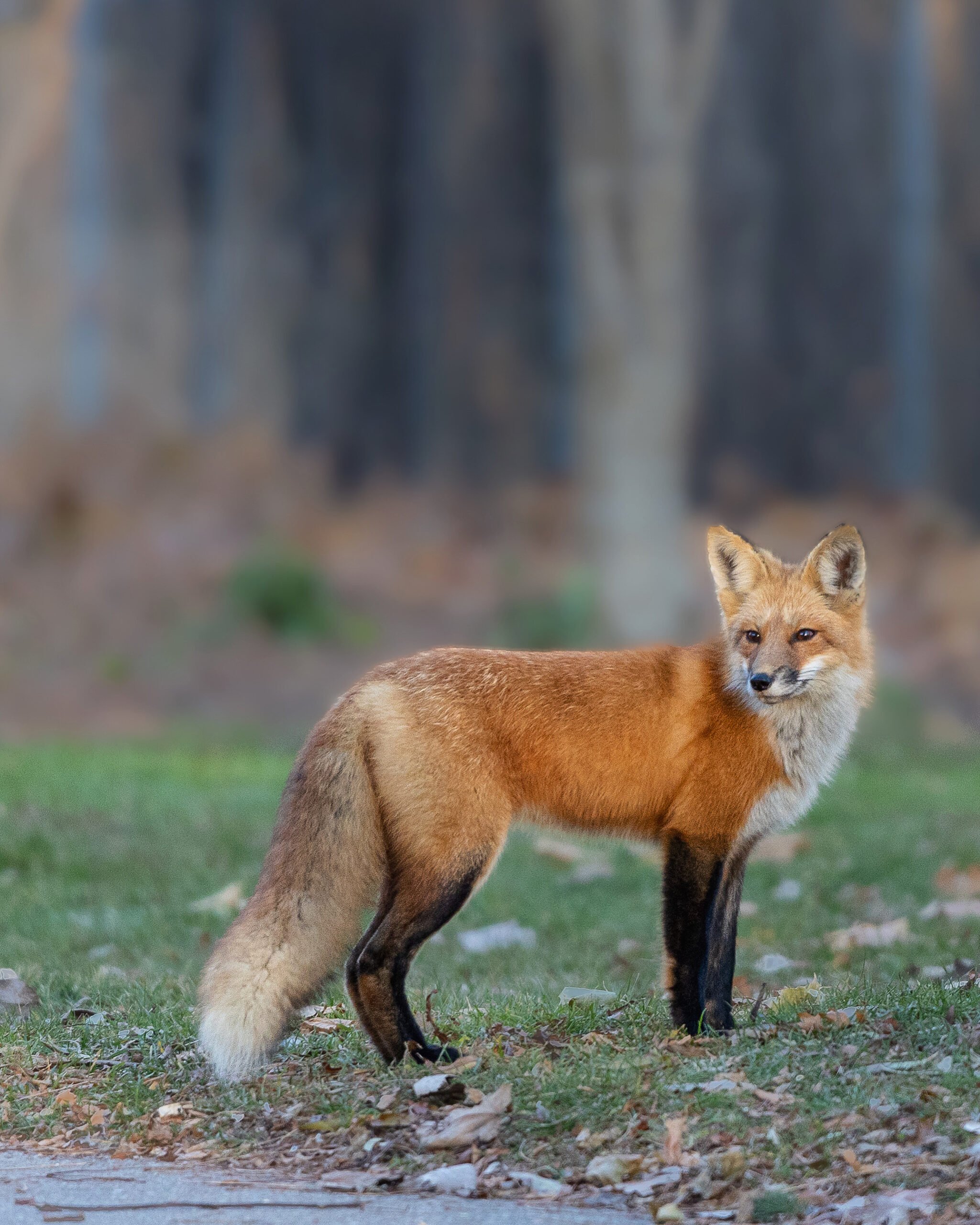
Photo by Ashley Toye
A fox has denned on my property
How lucky to have the chance to glimpse into the private lives of red foxes! While abundant in urban settings, foxes are typically very shy and reclusive creatures, preferring to den in areas they deem safe from predators, particularly humans. They meticulously scout potential den sites over several days to assess the risks and suitability of each location. In instances where people rarely use their backyards, if the area is overgrown, or there are structures in disrepair, a fox may perceive it as a secure spot to raise their kits due to the absence of predators or the superior shelter provided by an overgrown backyard or dilapidated shed/deck. Foxes and their offspring pose no threat to humans, making it both fascinating and enjoyable to observe the young ones as they mature, whether from a distance or from inside the house to avoid startling the babies or their parents. Kits typically begin venturing outside of the den at around 4-5 weeks of age when they are weaned, while the parents work tirelessly to procure prey and other food sources for the young ones to learn to recognize and consume. By approximately 2 months of age, the kits start accompanying the parents on short foraging trips to further develop the survival skills necessary for life in the wild.
By early fall, the young foxes are old enough to strike out on their own and establish new territories.
Overall, fox families do not remain at their natal den site for long, pose no threat to humans, and offer a delightful sight to behold. It’s important not to feed the family in any capacity, as it would hinder the kits’ development and create a dependency on humans that could be dangerous for them.
Tolerance is always preferable when a wild animal chooses to den in a backyard and is not causing any damage. Taking measures to evict a wild family can lead to complications and potentially result in an orphaning situation, or the family may have nowhere else to relocate, putting both parents and kits at risk. If tolerance is not feasible, something as simple as regular use of the backyard may prompt the family to relocate. For further guidance on discouraging foxes from your property, please refer to our section “Making your backyard less attractive to foxes.”
Can I trap, relocate, or kill nuisance foxes?
No. Trapping, relocating, or killing foxes is unethical, cruel and ineffective. Leghold traps or snares are inhumane and can catch unintended victims like children, pets and other wild animals, and foxes are notoriously difficult to catch via a net or box trap, especially if they’re healthy.
While relocating wildlife is often perceived as the “humane” option, it typically amounts to a death sentence for the animal being relocated, including foxes. Many individuals believe that wild animals can adapt to any environment and assume that relocating them to what appears to be a more “natural” habitat will benefit them. However, the reality is quite different. Most wildlife species have specific home ranges to which they are well adapted, and foxes are no exception. When relocated to unfamiliar territory, foxes will often attempt to return to their original home, leading to tragic outcomes such as being struck by vehicles or succumbing to territorial conflicts with established predators like coyotes in the new area. Additionally, the removal of nuisance wildlife frequently results in the separation of parents from their young, exacerbating the situation.
The “band-aid” nature of relocation fails to address the root causes of human-wildlife conflicts. It does not mitigate the underlying issues that attract wildlife to human-populated areas, such as the availability of food, water, or shelter. A more sustainable and effective approach involves implementing comprehensive strategies that focus on coexistence, habitat modification, and public education to minimize these conflicts in the long term.
For over a century, humans have persecuted and killed foxes as nuisance animals. Despite the monumental efforts to eradicate their populations, foxes persist and are continually expanding their range throughout North America. They now occupy the ecological niche that larger predators like wolves, cougars, and bears once dominated. Whether we appreciate their presence or not, foxes are here to stay.
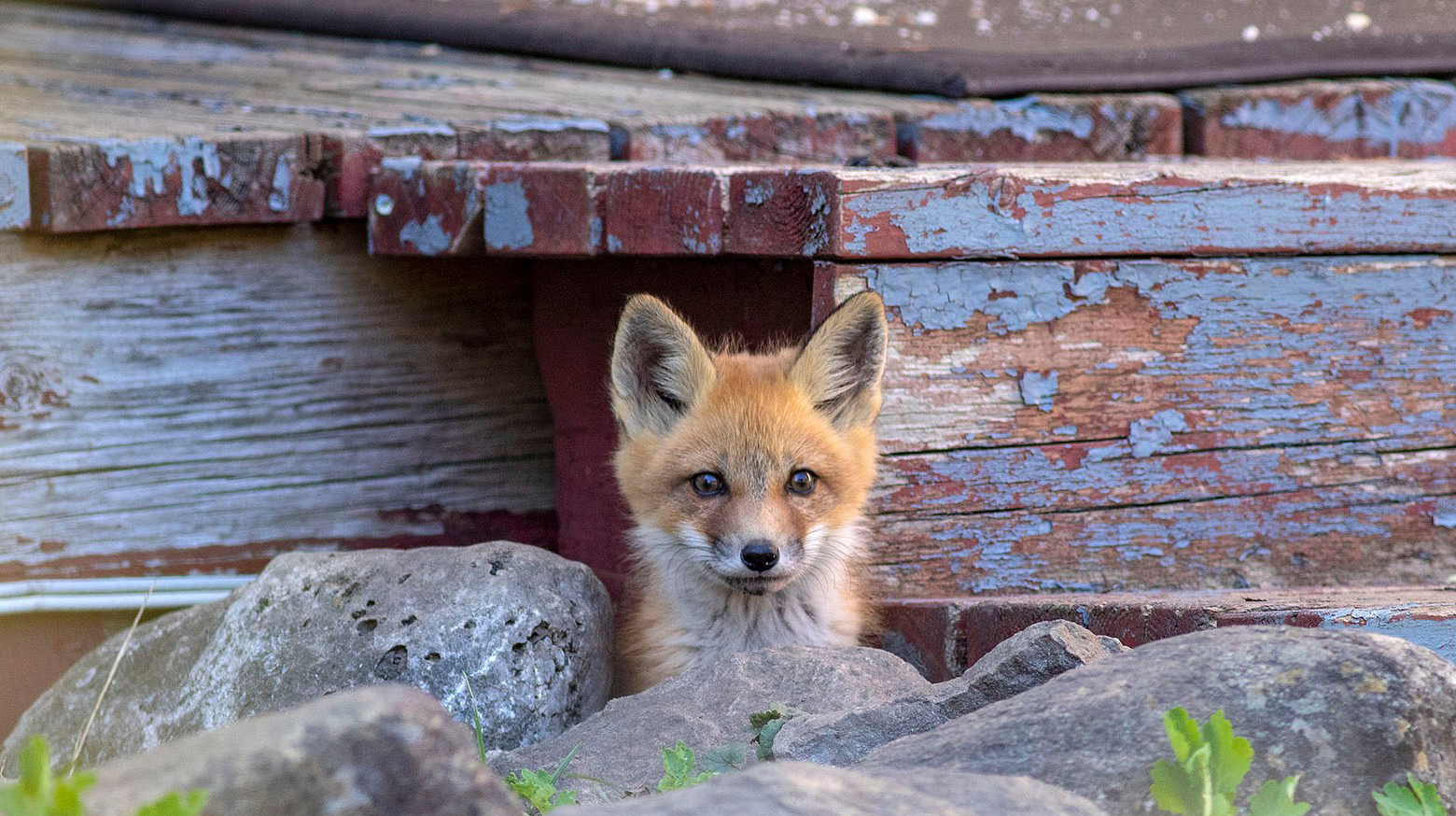
Photo by Ann Brokelman
What to do if you see a sick or injured fox
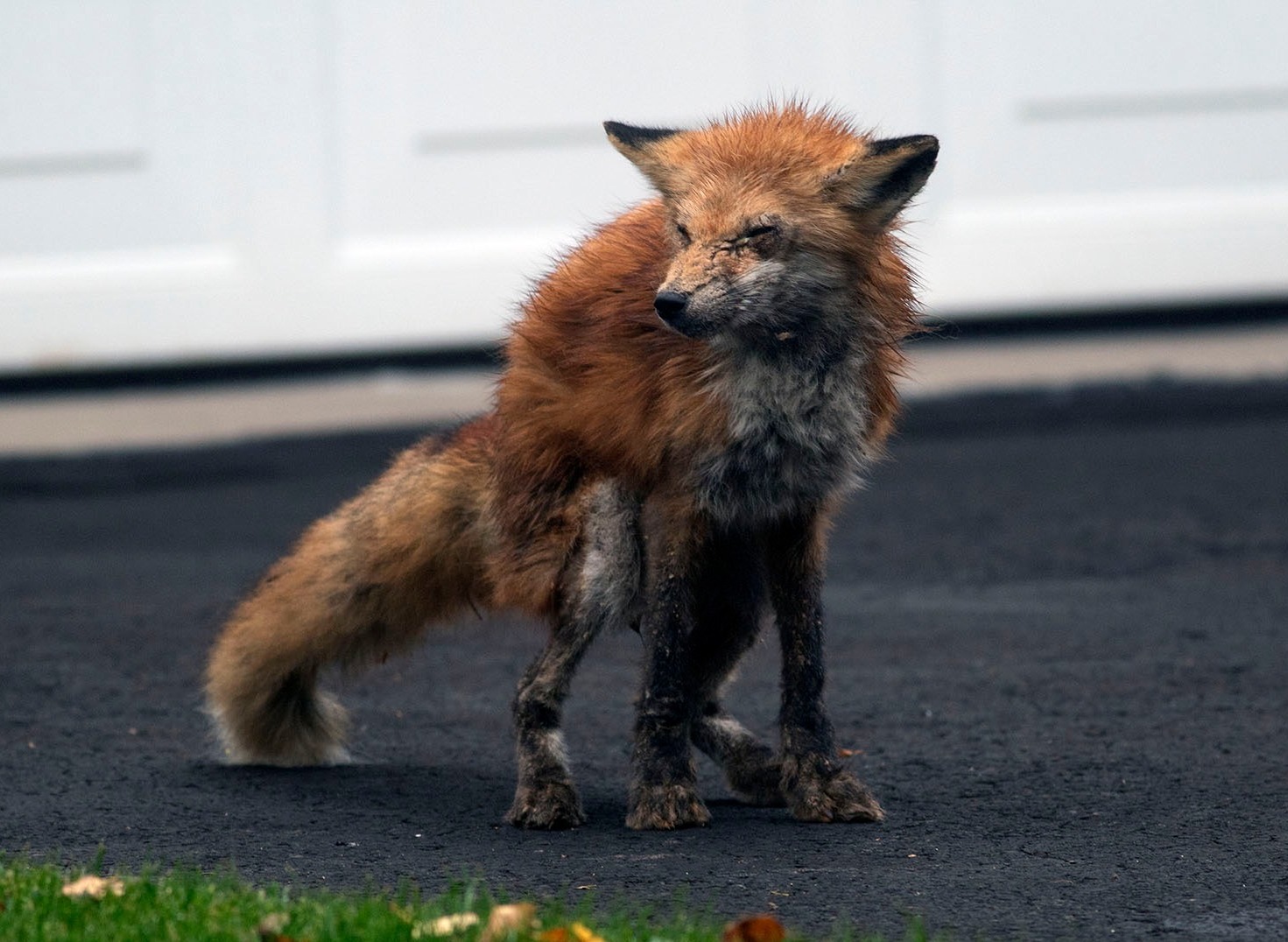
A sick or injured fox may exhibit behaviour perceived as bold or docile by commonly showing up during the daytime despite human activity, due to a range of factors linked to their compromised health. When foxes are unwell, they may experience increased stress and discomfort, disrupting their usual nocturnal habits. The pain or discomfort associated with illness or injury could drive them to seek food or resources more urgently, leading them to venture out in daylight hours. Additionally, weakened individuals might struggle to maintain their usual caution and aversion to human presence, making them more visible during daytime foraging or movement.
One of the most prevalent ailments afflicting urban foxes is a condition known as “mange.” Sarcoptic mange is a parasitic mite that burrows into the host’s skin causing relentless itching, resulting in noticeable fur loss and self-inflicted wounds. These animals are particularly vulnerable in winter, as they struggle to find respite from the harsh cold, posing a severe threat to their lives unless they get help.
TWC tracks sightings of sick or injured foxes in the GTA with the goal of rescuing and rehabilitating them. If you encounter a sick or injured fox, please contact your nearest wildlife rehabilitator to inform them. If you are situated in the GTA, please complete TWC’s online request for assistance form, providing details about when and where you spotted the fox, and attach any available photos.

